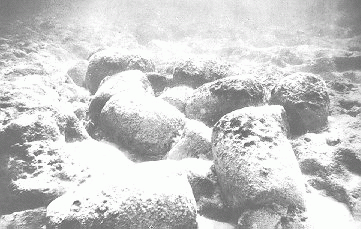The explorers said they believed the mysterious structures, discovered at the astounding depth of around 2,100 feet and laid out like an urban area, could have been built at least 6,000 years ago. That would be about 1,500 years earlier than the great Giza pyramids of Egypt.
“It’s a really wonderful structure which looks like it could have been a large urban center,” said Soviet-born Canadian ocean engineer Paulina Zelitsky, from British Columbia-based Advanced Digital Communications (ADC).
Zelitsky said the structures may have been built by unknown people when the current sea-floor actually was above the surface. She said volcanic activity may explain how the site ended up at great depths below the Caribbean Sea.
In July 2000, ADC researchers using sophisticated side-scan sonar equipment identified a large underwater plateau with clear images of symmetrically organized stone structures that looked like an urban development partly covered by sand. From above, the shapes resembled pyramids, roads and buildings, they said.
This past July, ADC researchers, along with the firm’s Cuban partner and experts from the Cuban Academy of Sciences, returned to the site in their ship “Ulises.” They said they sent a miniature, unmanned submarine called a Remotely Operated Vehicle (ROV) down to film parts of the 7.7-square-mile area.
Those images confirmed the presence of huge, smooth, cut granite-like blocks in perpendicular and circular formations, some in pyramid shapes, the researchers said. Most of the blocks, measuring between about 6.5 and 16 feet in length, were exposed, some stacked one on another, the researchers said.
Others were covered in sediment and the fine, white sand that characterizes the area, the researchers said.
The intriguing discovery provided evidence that Cuba at one time was joined to mainland Latin America via a strip of land from the Yucatan Peninsula, the researchers said.
“There are many new hypotheses about land movement and colonialization, and what we are seeing here should provide very interesting new information,” Zelitsky said.
ADC’s deep-water equipment includes a satellite-integrated ocean bottom positioning system, high-precision side-scan double-frequency sonar, and the ROV. The company currently is commissioning what it calls the world’s first custom-designed ocean excavator for marine archeology to begin work both at the Guanahacabibes site and at ship wrecks.
ADC is the deepest operator among four foreign firms working in joint venture with President Fidel Castro (news – web sites)’s government to explore Cuban waters containing hundreds of treasure-laden ships from the colonial era.
The Canadian company already has discovered several historic sunken Spanish ships.
In an earlier high-profile find, ADC was testing equipment in late 2000 off Havana Bay when it spotted the century-old wreck of the American battleship USS Maine. The ship had not been located since it blew up mysteriously in 1898, killing 260 American sailors and igniting the Spanish-American War.
The rush of interest in Cuba’s seas in recent years is due in part to the Castro government’s recognition that it does not have the money or technology to carry out systematic exploration by itself, although it does have excellent divers.
The Scott Stones- Are They Real?

The ruins of temples dated at 12,000 years old have been found near Bimini, Bahamas. Megalithic structures are not supposed to be in the Bahamas.
Preliminary analysis has revealed that the original structures, although smaller in size than the Great Pyramid of Giza, appear to have been more advanced.
Casing stones have been measured which are of the same unique angle as those at the Great Pyramid.
The ruins are megalithic and bear a remarkable resemblance to ancient sites in Egypt. So called “quarry marks” found in the Aswan quarries and also on the Great Pyramid, itself, appear to be identical matches with those found on the Bimini temple stones.
One major difference, however, between the Egyptian sites and these stones is that on The Bimini stones you find a great number of sky maps which have recorded the paths of various heavenly bodies. The major concern of the mysterious ancient civilization that produced these heavenly maps seems to have been Saturn and Jupiter – with the oldest records reflecting an emphasis in Saturn.
Some of the stones are under water and some of them are under the sand under water. They are not in their original formation.
It appears that the most important or revered numbers associated with these ruins were the numbers five and nine. These numbers were also of great significance to the ancients of Egypt and Meso-America.
Evidence indicates that a “checkerboard” calculator system was being used. Examples of this system were found on top of the Great Pyramid and were long used for numerical calculations in Meso-America.
This same checkerboard pattern shows up on the lintel stones of temples built by Celts of Iberian origin. Also, according to some astronomers, this pattern served as a calendar regulator to measure the sunrise and sunset directions on solstices and equinoxes.
Other characteristics closely match features at megalithic sites in Peru, the Yucatan, Ireland and Scandinavia.
Analysis of these enigmatic ancient temples built near Bimini over 12,000 years ago has only just begun.
Although many maps of the heavenly realm adorn various walls of these mysterious Bimini temples, there is an almost complete lack of other markings. Of the limited glyphs that do exist, however, several match those found in the famous Altamira Cave in Spain (known as the Sistine Chapel of pre-history) which contains the well-known bison painting. In addition, there are exact orbital plots of the planets and what seem to have been intricate star shafts, metal-coated walls, and intermingled stones of various colors.
One of the unique features of the ancient temple ruins, built near Bimini by an unknown advanced civilization which apparently was thriving while most of the rest of the world was plodding through the Stone Ages, is that these stones may be far more likely to yield an accurate account of their true age than most of the famous megalithic sites around the world.